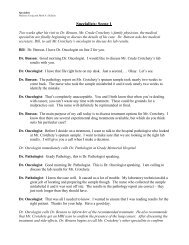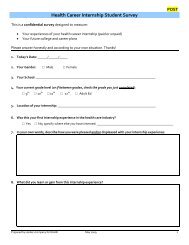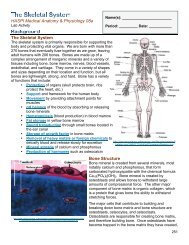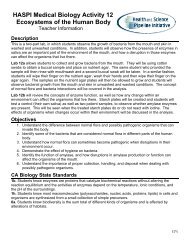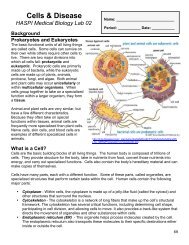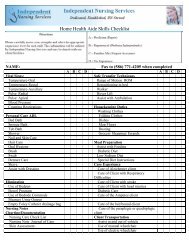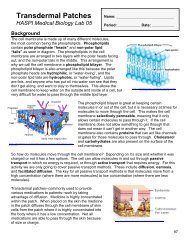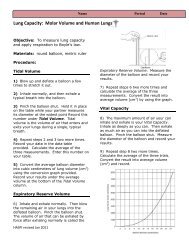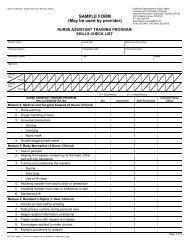Create successful ePaper yourself
Turn your PDF publications into a flip-book with our unique Google optimized e-Paper software.
Using the plastic pipette add 1 drop of Blood to the 0.9% Saline test tube. SwirlStep 5gently. The solution should remain cloudy, and the word “LYSIS” should not bevisible, demonstrating NO hemolysis. This is your negative control for thisexperiment.Solutions A, B, C, and D contain one of the following solutes: glucose, sucrose,Step 6urea, or glycerol.Have another student ready to start the timer immediately once the blood is added toStep 7the solution.Using the plastic pipette, add 1 drop of Blood to the test tube labeled A and swirlgently. Record in Data Table 1 the Initial Time the blood was added. Watch theStep 8 tube carefully for the moment the word “LYSIS” becomes visible. Refer to yourpositive and negative control if you are uncertain whether hemolysis has occurred.Record this as the End Time in Data Table 1.Subtract the Initial Time from the End Time, and record this as the Time forStep 9<strong>Hemolysis</strong>.Observe the tube for a maximum of 15 minutes. If hemolysis does not occur withinStep 1015 minutes, record “NO HEMOLYSIS” in Data Table 1.Step 11 Repeat steps 8 – 11 for solutions B, C, and D.Follow your instructor’s directions to CAREFULLY dispose of the solutions and washStep 12the test tubes.Data Table 1InitialTimeEndTimeTime of<strong>Hemolysis</strong>Solution ASolution BSolution CSolution DTable 2 contains information on the solutes that are in each of the unknown solutions. Use this tableto answer the analysis questions.Table 2Solute Concentration Chemical Molecular Permeability Polarity(molarity) formula WeightGlucose 0.5 M C 6 H 12 O 6 180 permeating polarGlycerol 0.5 M C 3 H 5 (OH) 3 92 permeating non-polarSucrose 0.5 M C 12 H 22 O 11 342 non-permeating polarUrea 0.5 M (NH 2 ) 2 CO 60 permeating non-polar107
Analysis Questions - on a separate sheet of paper complete the following1. Would a faster rate of osmosis make the rate of hemolysis faster or slower?2. Would permeating or non-permeating solutes enter a red blood cell faster? Which wouldcause hemolysis faster?3. Would smaller or larger solutes enter a red blood cell faster? Which would causehemolysis faster?4. Would polar or non-polar solutes enter a red blood cell faster? Which would causehemolysis faster?5. If osmosis happens in solutions of small solutes BEFORE it happens in solutions of largesolutes, then would hemolysis in a glycerol solution happen before or after a glucosesolution?6. If osmosis happens in solutions of non-polar solutes BEFORE it happens in solutions ofpolar solutes, then would hemolysis in a glycerol solution happen before or after a glucosesolution?7. If osmosis does not happen in a solution containing non-permeating solutes, then wouldhemolysis occur in a sucrose solution?8. Which of the unknown solutions was the smallest and polar (A,B,C, or D)?9. Which of the unknown solutes was non-permeating (A,B,C, or D)?10.Rank the four unknown solutions on the expected rate of osmosis from FASTEST toSLOWEST and the rate of hemolysis from FASTEST to SLOWEST.UnknownSolutionABCDRate of Osmosis(1-4 fastest toslowest)Rate of<strong>Hemolysis</strong> (1-4fastest toslowest)11.Given the information you have collected and observed, identify each of the unknownsolutes:UnknownSolution SoluteABCD12.CONCLUSION: In 1-2 paragraphs summarize the procedure and results of this lab.As instructed above, cut out and tape to the test tubes to make hemolysis easier to observe.lysis lysis lysis lysis lysis lysis108



